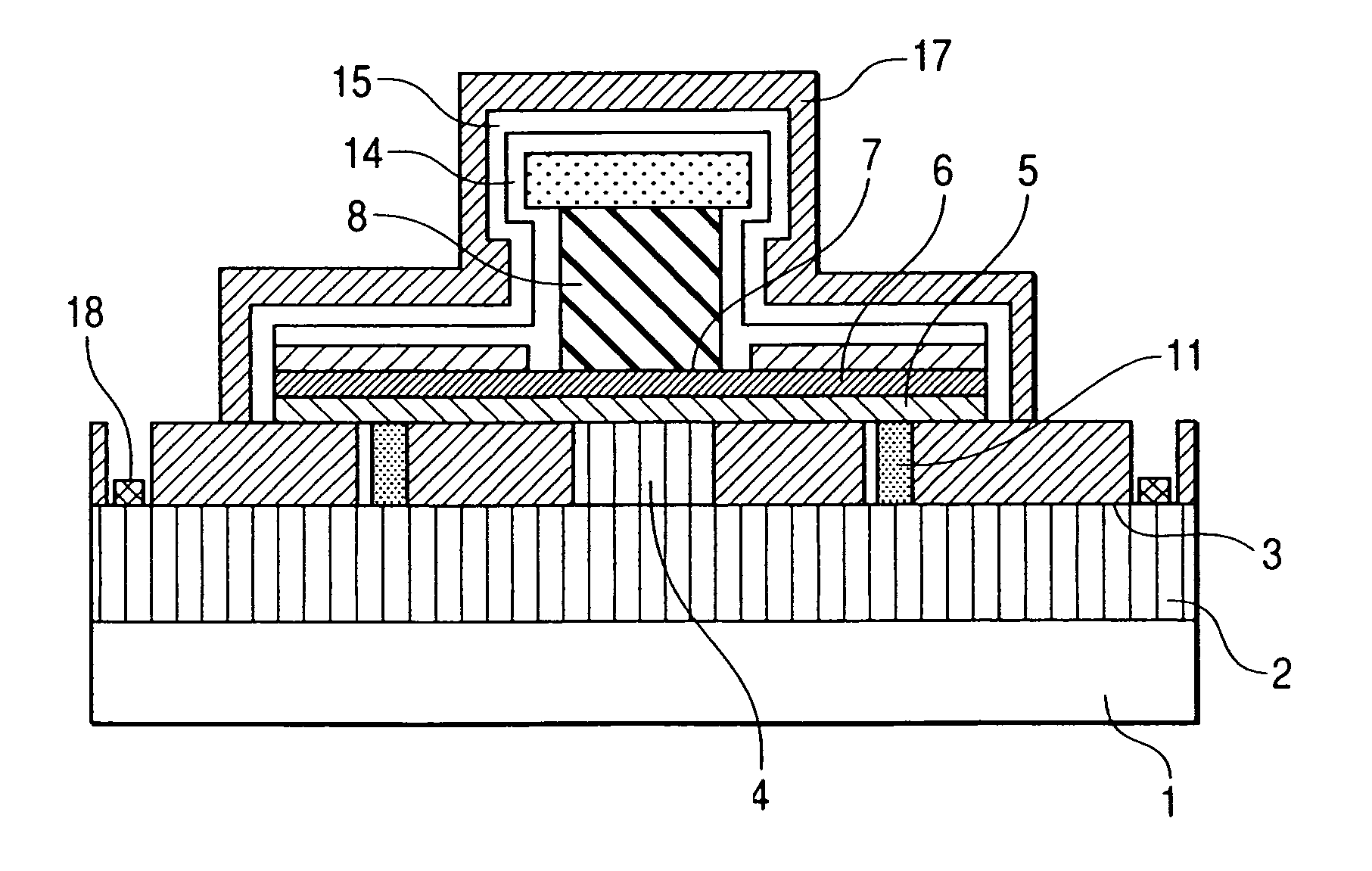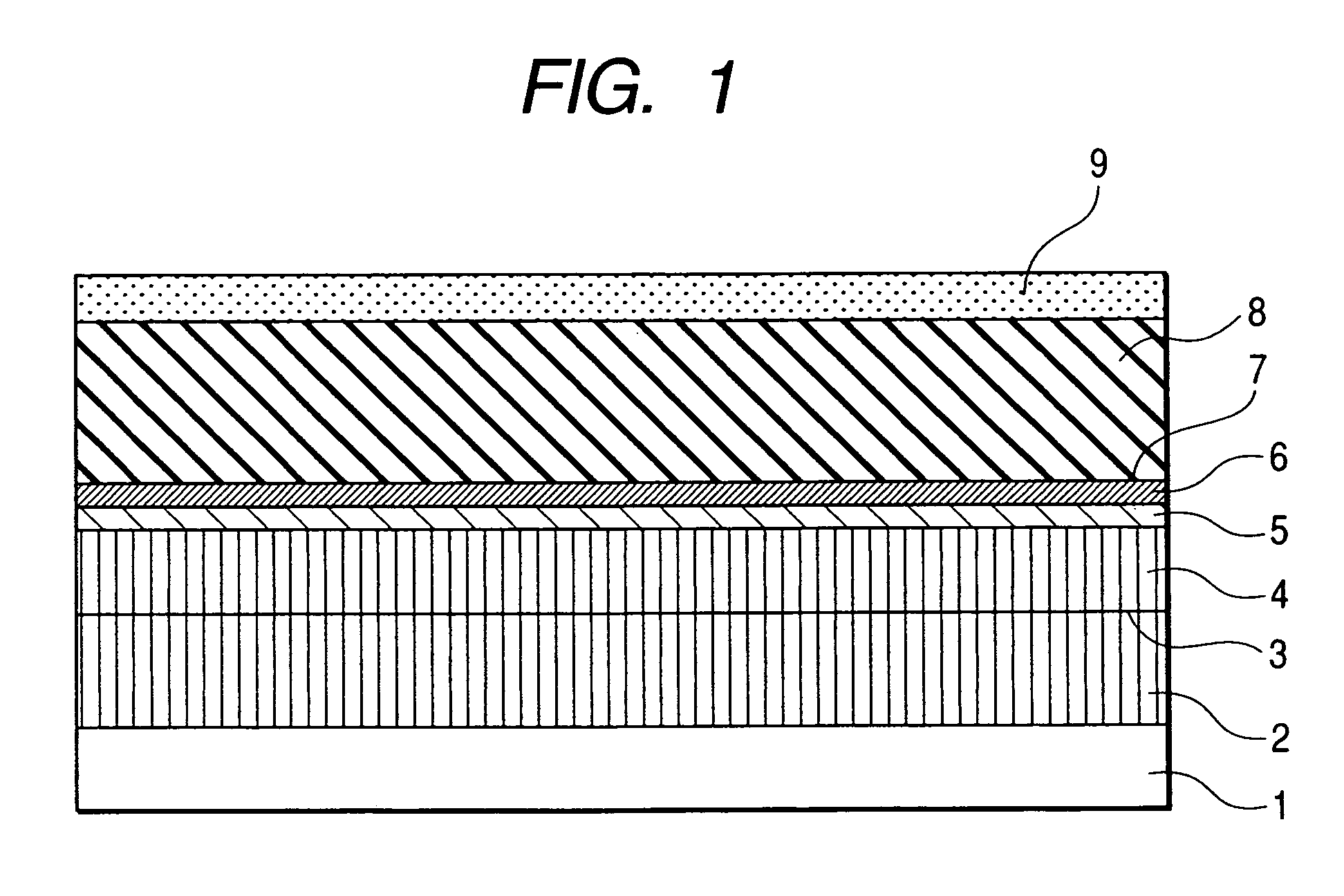Semiconductor device and method of manufacturing the same
a technology of semiconductor devices and semiconductors, applied in the direction of semiconductor devices, electrical devices, transistors, etc., can solve the problems of insufficient mechanical strength, and achieve the effect of small base-collector junction capacity and high maximum oscillation frequency
- Summary
- Abstract
- Description
- Claims
- Application Information
AI Technical Summary
Benefits of technology
Problems solved by technology
Method used
Image
Examples
first embodiment
[0077]An npn-type C-up HBT, a first embodiment of the present invention, will be described using FIGS. 1 to 8C. In the present embodiment, as illustrated in longitudinal structural views of FIGS. 8B and 8C, a second emitter contact layer 4 is opened by etching from a window structure and by side-etching, and an effective emitter area of 0.5×0.5 μm2 (a contact area between the second emitter contact layer 4 and an emitter layer 5) is smaller than a base-collector area of 0.7×0.7 μm2 (a contact area between a base layer 6 and a collector layer 8). FIG. 8A is a top view of the C-up HBT, and FIGS. 8B, 8C are sectional views of an associated device, taken along lines 8B-8B, 8C-8C, respectively, in FIG. 8A.
[0078]A manufacturing process for the C-up HBT will be described below using FIGS. 1 to 8C.
[0079]First, seven layers are formed on a semi-dielectric GaAs (100) substrate 1. That is to say, a first emitter contact layer 2, an etching stop layer 3, a second emitter contact layer 4, an n-t...
second embodiment
[0092]A second embodiment relates to a C-up HBT fabricated by forming an EB electrode after forming window structures, instead of forming an EB electrode before forming the window structures of the C-up HBT in the first embodiment. The present second embodiment will be described below using FIGS. 9 to 16C.
[0093]A layer structure similar / equivalent to that of the first embodiment is formed using metal-organic vapor phase epitaxy. The formation of the above layer structure is followed by depositing a WSi layer 9 (WSi: 0.3 in Si molar ratio, 0.5 μm in film thickness) on entire wafer surface using a high-frequency sputtering method (see FIG. 9). After that, dry etching with photolithography and CF4 is used to process the WSi layer into a desired shape and thus form a collector electrode 9. FIG. 10A shows a mask layout view, and FIG. 10B shows a longitudinal sectional view of the device formed in this process phase.
[0094]Next, dry etching with SF6 and SiCl4 and wet etching with a liquid ...
third embodiment
[0102]A third embodiment relates to an npn-type C-up HBT created by making changes as follows to the materials used in the first embodiment:
[0103](1) A semi-dielectric InP (100) substrate is used instead of the semi-dielectric GaAs (100) substrate 1.
[0104](2) An emitter contact layer made of highly doped InAlGaAs and having a 0.53 InAs molar ratio, a 5×1018cm−3 Si concentration, and a 0.5 μm film thickness, is formed instead of the first emitter contact layer 2 made of highly doped n-type GaAs.
[0105](3) An etching stop layer made of highly doped InAlGaAs and having a 0.5 InAs molar ratio, AlAs and GaAs molar ratios that are arbitrarily variable in progressive form, a 5×1017cm−3 Si concentration, and a 0.1 μm film thickness, is formed instead of the etching stop layer 3 made of highly doped n-type InGaP.
[0106](4) An emitter contact layer made of highly doped InGaAs and having a 0.5 InAs molar ratio, a 5×1018cm−3 Si concentration, and a 0.5 μm film thickness, is formed instead of the ...
PUM
 Login to View More
Login to View More Abstract
Description
Claims
Application Information
 Login to View More
Login to View More - R&D
- Intellectual Property
- Life Sciences
- Materials
- Tech Scout
- Unparalleled Data Quality
- Higher Quality Content
- 60% Fewer Hallucinations
Browse by: Latest US Patents, China's latest patents, Technical Efficacy Thesaurus, Application Domain, Technology Topic, Popular Technical Reports.
© 2025 PatSnap. All rights reserved.Legal|Privacy policy|Modern Slavery Act Transparency Statement|Sitemap|About US| Contact US: help@patsnap.com



